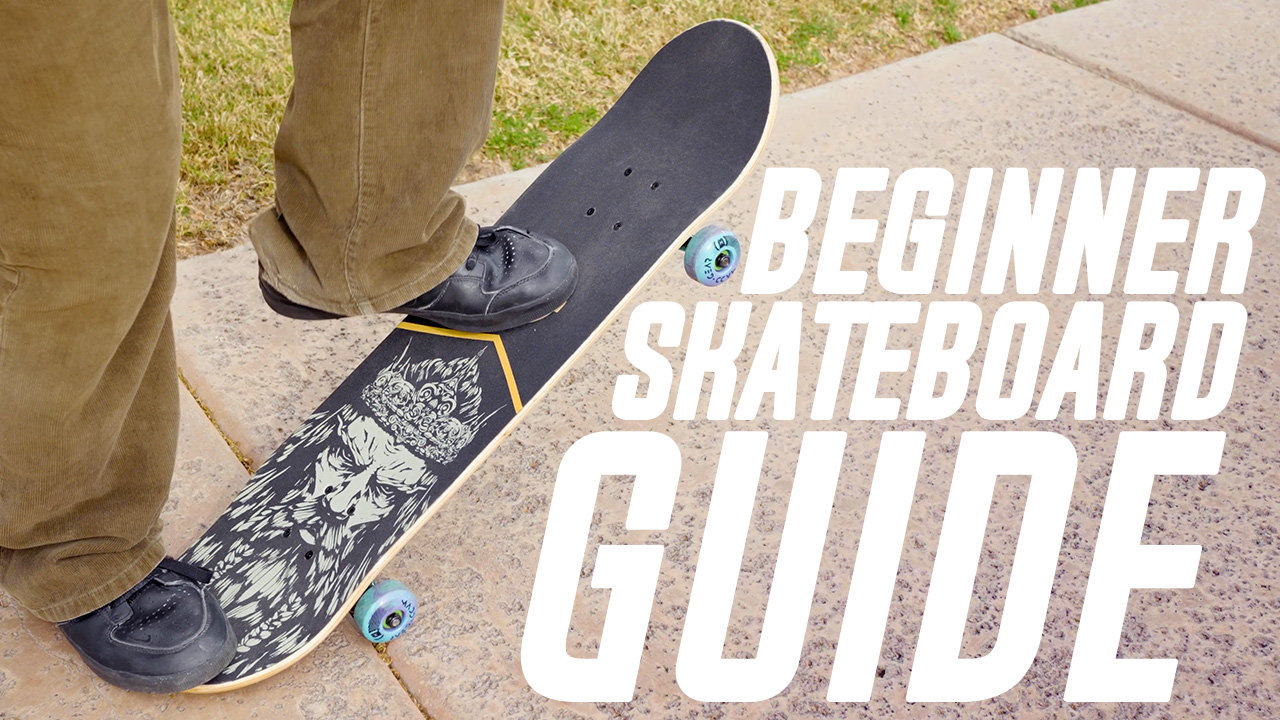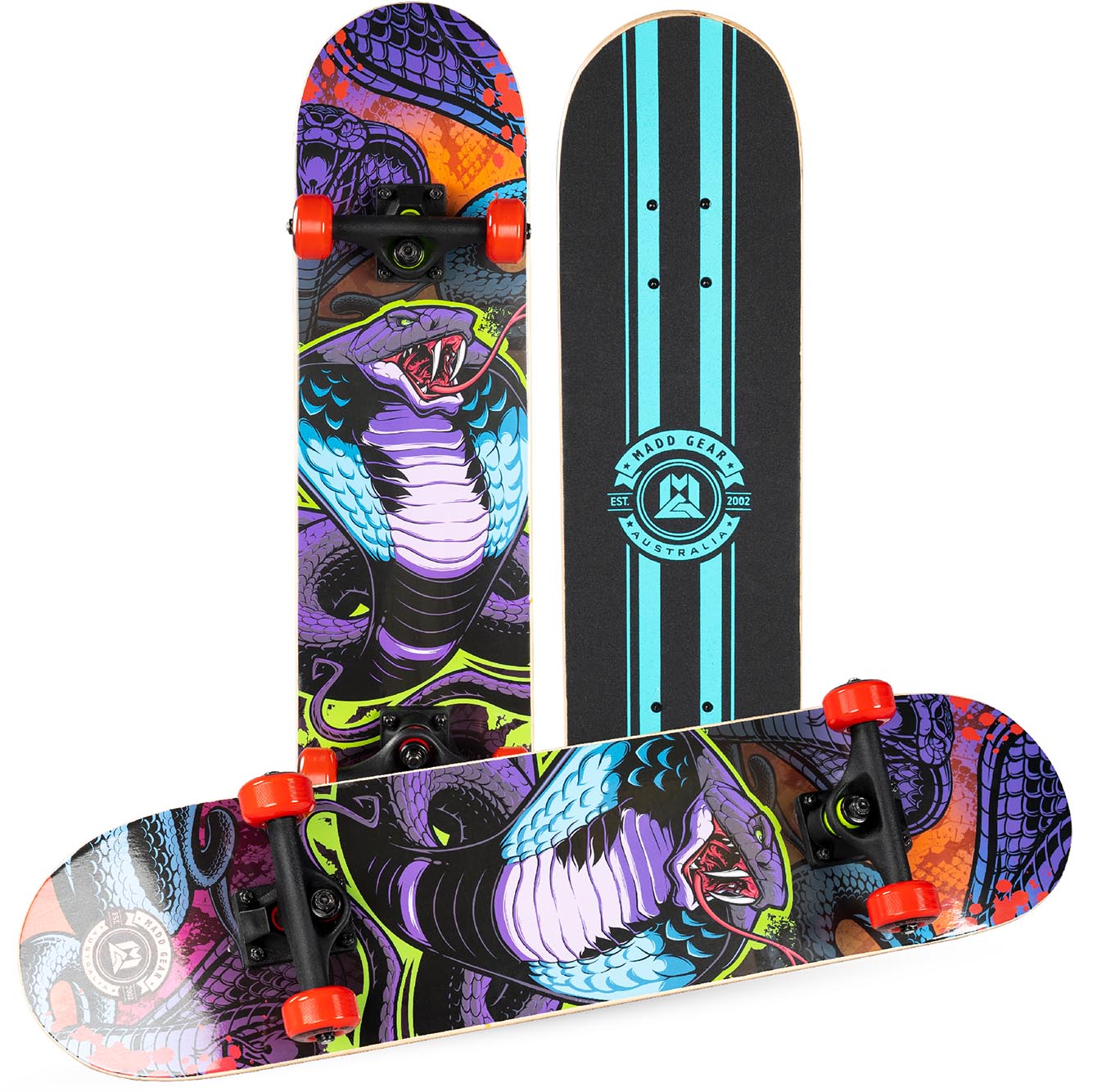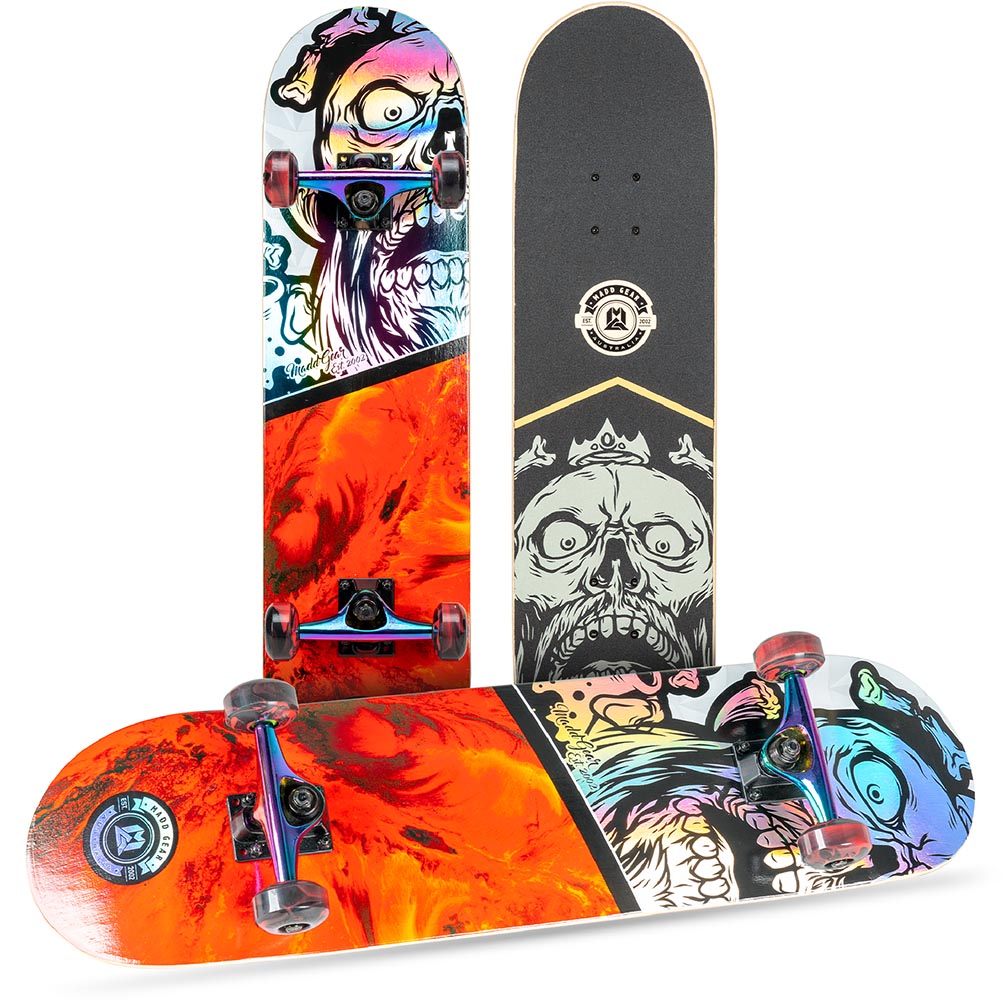Ultimate Beginner Skateboard Guide: Tips for Starting Out
Welcome to Madd Gear's comprehensive Beginner Skateboard Guide, where we will discuss everything you need to know about getting into the sport of skateboarding. As a parent of a youngster eager to try outdoor activities, has just started skating, or an individual wishing to resume skating after some absence, this beginner skateboard guide is here for you.
Throughout this beginner skateboard guide, we'll cover choosing the right skateboard for beginners and understanding its components so you can be confident in selecting a quality skateboard. We'll also dive headfirst into junior-sized skateboards for younger skaters and finding your preferred skateboarding style if you have just started skating.
In addition, our Beginner Skateboard Guide emphasizes the importance of wearing protection while learning and offers advice on assessing skill level before purchasing new gear. With these insights at hand, you'll be well-equipped to hit your local skate park with confidence.

Junior-Sized Skateboards for Younger Skaters
If you're shopping for a younger skater or someone with smaller feet, it's important to consider a junior sized skateboard. These boards are specifically designed for beginners and provide an easier learning experience while still offering room for growth as their skills improve.
Benefits of Choosing a Junior-Sized Board
- Easier control: Smaller decks make it simpler for young skaters to maneuver the board, helping them build confidence as they start skateboarding.
- Better fit: A junior-sized skateboard is designed with smaller feet in mind, ensuring proper foot placement on the grip tape which aids in balance and stability.
- Suitable size progression: As your child grows and improves their skills, they can transition to larger boards without feeling overwhelmed by sudden changes in size or weight.
Recommended Models
In this beginner skateboard guide, we suggest investing in a quality skateboard as it's essential for an enjoyable experience. Here are some recommendations:
-
Madd Gear LTR Complete: Known primarily for our quality pro scooters, Madd Gear also offers excellent complete skateboards tailored towards younger riders. Our MG LTR or Learn to Skate series features soft wheels perfect for smooth rides at local skate parks or learning tricks on flat surfaces.

-
Madd Gear Grind Complete: Our Grind Complete Skateboards step it up a level and are our premium double kicktail boards. Ideal for beginner to advanced skaters, these completes feature high quality maple decks and aluminum trucks.

Pro Tip: Invest in a skate tool that will allow you to adjust trucks as needed for optimal performance tailored towards your specific needs.
For those just starting out, junior-sized skateboards can offer a gentler learning experience and more control than larger boards. It is vital for those who have been away from skateboarding to gauge their proficiency prior to obtaining new equipment.
When buying a skateboard for younger or beginner skaters, it's important to consider junior-sized boards that offer easier control and better fit. Recommended models include Madd Gear LTR and Grind Complete boards. You can talk to us on our Live Chat during business hours for expert advice on choosing the right board size and type or speak with your local skate shop. Invest in a skate tool to tune-up your board.
Importance of Wearing Protection While Learning
Safety should always be prioritized when learning any new sport, especially one involving high speeds and potential falls such as skateboarding. In order to protect yourself physically and mentally (by building confidence), wearing protective equipment is highly recommended during the initial stages of practice sessions until you achieve mastery over various tricks and maneuvers within the discipline itself. This significantly reduces the risk of injury throughout your journey towards becoming a proficient rider.
Types of Protective Gear: Helmets, Pads, Wrist Guards
- Helmets: A crucial piece of safety gear for all skaters, helmets protect your head from serious injuries in case of a fall or collision. Make sure to choose a helmet that meets safety standards like those set by CPSC.
- Pads: Knee and elbow pads provide additional protection against scrapes, bruises, and more severe injuries during falls. Look for pads with adjustable straps to ensure a secure fit.
- Wrist Guards: These guards help prevent wrist fractures by providing support while absorbing impact forces during falls. Choose wrist guards that are comfortable yet offer adequate protection.
How to Choose the Right Size and Fit for Maximum Safety
Selecting appropriate sizes for your protective gear ensures maximum comfort and effectiveness in preventing injuries. Here are some tips on finding the right size:
- Helmets: To find an accurate measurement for your helmet size, use a flexible tape measure around your forehead just above eyebrows; this will give you an approximate circumference value which can then be compared against manufacturer's sizing charts provided online or at your local skate shop.
- Pads: Measure the circumference of your knee and elbow joints to determine appropriate pad sizes. Use these measurements when consulting sizing charts from various brands.
- Wrist Guards: To find the right size wrist guard, measure around your hand just below knuckles (excluding thumb). Compare this measurement with available sizing options provided by manufacturers.
In addition to wearing protective gear, it's essential to practice safe skating habits like learning tricks gradually, starting on flat surfaces before progressing onto more challenging terrain, and being mindful of fellow skaters in shared spaces. By following our beginners guide and investing in quality safety equipment, you can enjoy the process of learning new skills while minimizing risks associated with skateboarding.
It is crucial to don protective gear while skateboarding in order to reduce the possibility of harm. Hence, it is critical to be aware of the parts that form a skateboard and how they collaborate for peak execution.
When learning to skateboard, safety should always come first. Wearing protective gear such as helmets, pads and wrist guards is highly recommended until you have mastered various tricks and maneuvers. It's also important to practice safe skating habits like starting on flat surfaces before progressing onto more challenging terrain and being mindful of other skaters in shared spaces.
Understanding Skateboard Components
To make an informed decision when buying your first skateboard, it is essential to be aware of the various components that constitute a board; here we'll discuss everything from decks and trucks to wheels and bearings. This section will cover everything from decks and trucks to wheels and bearings so you can confidently select the best options for your needs as a beginner skater.
Decks: Material Types, Sizes & Shapes
The deck is where you flat sole on the board surface or where you stand while skateboarding. Wood is usually the material of choice for skateboard decks, with maple as a popular option. A quality skateboard deck should have multiple layers of wood laminated together for added strength and durability. Deck sizes vary in width (7.5-8.5 inches) and length (28-32 inches), depending on personal preference and skating style.
- Popsicle-shaped decks: These are symmetrical with rounded edges - perfect for beginners learning tricks.
- Cruiser decks: With wider shapes, these boards offer more stability but may be less suitable for advanced tricks.
- Longboards: Characterized by its longer deck and larger wheels, designed for cruising and transportation over longer distances with enhanced stability and smoothness.
- Old-school decks: Featuring retro design and composite deck material, they are compact and easy to carry or fit in your locker at school.
Trucks: Materials & Sizing Considerations
Your skateboard trucks connect the wheels to the deck and help control turning movements. Quality trucks are usually made of aluminum alloy but on beginner boards they can also be made from a lightweight composite materials. When selecting trucks, ensure they match the width of your deck to maintain stability and control.
Wheels & Bearings: Hardness Ratings & Choosing Appropriate Options
Skateboard wheels are made from polyurethane and come in various hardness levels (measured by durometer). Softer wheels (78A-87A) provide more grip on rough surfaces, while harder wheels (88A-101A+) offer better speed and slide capabilities. For beginners, a medium-hard wheel (90A-99A) is recommended for versatility across different terrains.
- Diameter: Wheel size affects acceleration and turning ability. Smaller wheels (56mm) suit ramp or vert skating.
- Bearings: These small metal components inside the wheel allow it to spin smoothly. Look for bearings with an ABEC rating of at least 5 - anything lower may hinder performance.
Understanding skateboard components is essential for any beginner looking to get into the sport. Considering the desired skateboarding style, it is prudent to select a board accordingly.
This section provides a beginner skateboard guide that covers the essential components of a skateboard, including decks, trucks, wheels and bearings. It explains the different types of decks available based on their sizes and shapes such as popsicle-shaped, cruiser and old-school decks. Additionally, it highlights important considerations when selecting trucks to ensure stability and control while skateboarding. Finally, it recommends medium-hard wheels with appropriate durometer levels for versatility across various terrains.
Finding Your Preferred Skateboarding Style
As a beginner skateboarder, discovering your preferred style of skating is crucial in determining which type of board will suit you best. Whether you're interested in street skating or focusing on ramps, this section provides guidance towards identifying personal preferences early on during your journey towards mastery within the sport.
Street vs Park vs Cruiser Skateboarding Styles
Street skateboarding involves performing tricks and maneuvers on urban obstacles like stairs, ledges, handrails, and more. This style requires a versatile complete skateboard, with smaller wheels for better control and flip tricks. Soft wheels are recommended to help absorb impact when landing from jumps.
Park skateboarding, also known as transition or bowl riding, takes place at local skate parks where skaters ride smooth transitions between ramps and bowls. A wider deck with medium-sized soft wheels is ideal for park skaters who want stability while carving through transitions.
Cruiser skateboarding Cruiser and longboard skateboards serve different riding styles and purposes. A cruiser skateboard is compact, ideal for urban commuting and maneuvering in crowded areas. Longboard skateboards have longer decks and larger wheels, providing stability and comfort for cruising, downhill riding, and carving over longer distances.
Selecting Boards Tailored to Specific Styles
- If you're younger or just beginning: Look for a narrower deck (around 7.5-8 inches wide) with small-to-medium sized wheels (52-56mm).
- If you're slightly more advanced: Opt for a slightly wider deck (8-8.25 inches) combined with medium-sized wheels (54-58mm).
- If general cruising is your goal: Choose a wider and longer deck (8.25 inches or more) and pair it with larger wheels (62-70mm).
Remember that finding the perfect skateboard setup for your preferred style might take some trial and error. Test out various combos of decks, wheels and trucks to find the one that's best for you - don't be afraid to try something new.
As a beginner skateboarder, it's important to identify your preferred style of skating early on. Whether you're interested in street, park or general cruising skateboarding, each requires specific board setups tailored to the type of tricks and maneuvers performed. Experimenting with different equipment and seeking guidance from experienced skaters can help you find the perfect setup for your skill level and interests.
FAQs in Relation to Beginner Skateboard Guide
How should a beginner start skateboarding?
A beginner should start by choosing the right skateboard, wearing protective gear, and finding a safe location to practice. Focus on learning basic skills such as pushing off, balancing, turning, and stopping before attempting tricks. Watching instructional videos or taking lessons can also be helpful.
How can I teach myself to skateboard?
Teach yourself to skateboard by watching online tutorials like our Skateboarding Basic Guide, practicing regularly in a safe environment, and breaking down each skill into smaller steps. Progress at your own pace and stay persistent through challenges.
How to skate step by step?
- Select the appropriate board size and safety gear.
- Determine your stance: regular (left foot forward) or goofy (right foot forward).
- Place front foot near middle of deck with toes pointing slightly outward.
- Push off gently with back foot while maintaining balance on front foot.
- Bend knees slightly for better stability during motion.
- Practice steering by shifting weight between heels and toes while riding.
How do beginners get comfortable on a skateboard?
Our beginner skateboard guide suggests getting comfortable by spending time simply standing flat sole on it without moving initially. Gradually progress to gentle pushes while focusing on balance. Practice frequently in short sessions for muscle memory development and increased confidence over time.
Conclusion
By following this Beginner Skateboard Guide, parents can help their children or teenagers start skating safely and confidently. Choosing the right skateboard, wearing protective gear, understanding components, and finding a preferred style are all important factors to consider when beginning skateboarding and keeping your feet on that grip tape.
Remember to always prioritize safety by wearing proper protection and choosing a complete skateboard from a trusted brand like Madd Gear. Committed learners can master the sport and relish in skateboarding's excitement with their fellow skaters for many years with practice.
Ready to start skateboarding? Check out Madd Gear's selection of quality skateboards here.



